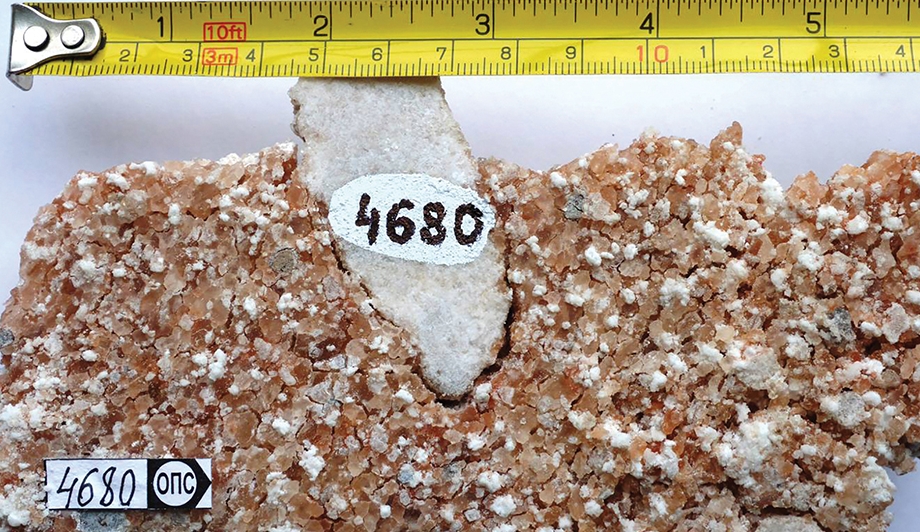A 2-billion-year-old chunk of sea salt provides new evidence for the transformation of Earth’s atmosphere into an oxygenated environment capable of supporting life as we know it.
The new study by an international team of researchers, led by the Universities of St Andrews and Princeton, finds that salts left over from ancient seawater reveal new information about the oxygenation of the Earth’s atmosphere more than 2 billion years ago.
The findings, published in Science (22 March), found that the rise in oxygen that occurred about 2.3 billion years ago, known as the Great Oxidation Event, was much more substantial than previously indicated.
“Instead of a trickle, it was more like a firehose,” said Dr Clara Blättler, a postdoctoral research fellow in the Department of Geosciences at Princeton and first author on the study, “It was a major change in the production of oxygen.”
The evidence for the profound upswing in oxygen comes from crystalized salt rocks extracted from a 1.2-mile-deep hole in the region of Karelia in northwest Russia. These salt crystals were left behind when ancient seawater evaporated, and they give geologists unprecedented clues to the composition of the oceans and atmosphere on Earth more than 2 billion years ago.
The key indication of the increase in oxygen production came from finding that the mineral deposits contained a surprisingly large amount of a component of seawater known as sulfate, which was created when sulfur reacted with oxygen.
“The story is the salts,” said Dr Mark Claire, School of Earth and Environmental Sciences at The University of St Andrews. “Decades of geologic observation by researchers at St Andrews (in collaboration with colleagues in Norway and Russia) lead to the discovery of a 600 metre thick pile of evaporated 2-billion-year-old seawater, in a drill core 2.5 km below the surface in Russia’s Karelia basin. These are by far the oldest salt deposits ever discovered, and the well-preserved sulfate salts archive the aftermath of Earth’s most dramatic transition ever – the ‘Great Oxidation Event.”
After demonstrating that the sulfate salts had not been re-dissolved since they were originally deposited, researchers at St Andrews and Princeton University used state of the art geochemical measurements and modelling to show that the chemistry of the ancient seawater was similar to modern seawater.
Dr Claire added: “We’ve documented that 2 billion years ago, microbes and the Earth System were acting quite a bit like they do today. Cyanobacteria were making oxygen and this O2 was reacting with continental sulfides to make sulfate, which washed down rivers and into the oceans where concentrations built up. Tectonic forces restricted some portion of that ancient ocean into a basin something like the modern-day Mediterranean, and sea-level changes allowed for repeated cycles of evaporation to build up the giant piles of salt. These data and observations prove that what has long been called the ‘Great Oxidation Event’ was in fact great, and profoundly changed the chemistry of the atmosphere and oceans.”
“This is the strongest ever evidence that the ancient seawater from which those minerals precipitated had high sulfate concentrations reaching at least 30 percent of present-day oceanic sulfate as our estimations indicate,” said Professor Aivo Lepland, a researcher at the Geological Survey of Norway, a geology specialist at Tallinn University of Technology, and senior author on the study. “This is much higher than previously thought and will require considerable rethinking of the magnitude of oxygenation of Earth’s 2-billion-year-old atmosphere-ocean system.”
Oxygen makes up about 20 percent of air and is essential for life as we know it. According to geological evidence, oxygen began to show up in the Earth’s atmosphere between 2.4 and 2.3 billion years ago.
Until the new study, however, geologists were uncertain whether this build up in oxygen – caused by the growth of cyanobacteria capable of photosynthesis, which involves taking in carbon dioxide and giving off oxygen — was a slow event that took millions of years or a more rapid event.
“It has been hard to test these ideas because we didn’t have evidence from that era to tell us about the composition of the atmosphere,” Blättler said. The recently discovered crystals provide that evidence. The salt crystals collected in Russia are over a billion years older than any previously discovered salt deposits. The deposits contain halite, which is called rock salt and is chemically identical to table salt or sodium chloride, as well as other salts of calcium, magnesium and potassium.
Normally these minerals dissolve easily and would be washed away over time, but in this case they were exceptionally well preserved deep within the Earth. Geologists from the Geological Survey of Norway in collaboration with the Karelian Research Center in Petrozavodsk, Russia, recovered the salts from a drilling site called the Onega Parametric Hole (OPH) on the western shores of Lake Onega.
The unique qualities of the sample make them very valuable in piecing together the history of what happened after the Great Oxidation Event. There has been a lot of debate as to whether the Great Oxidation Event, which is tied to increase and decrease in various chemical signals, represents a big change in oxygen production, or just a threshold that was crossed. The bottom line is that this paper provides evidence that the oxygenation of the Earth across this time period involved a lot of oxygen production.
http://science.sciencemag.org/content/early/2018/03/21/science.aar2687














